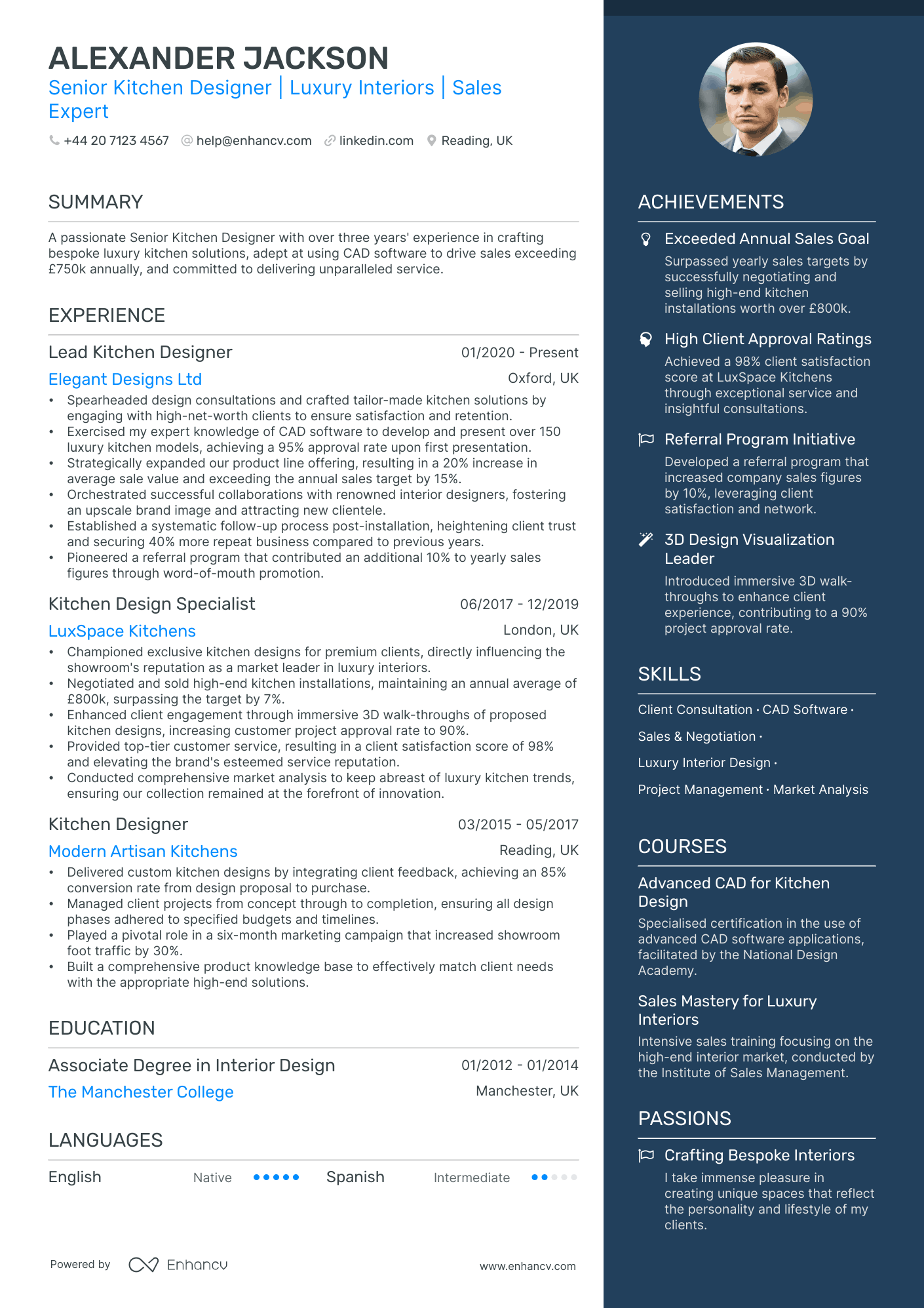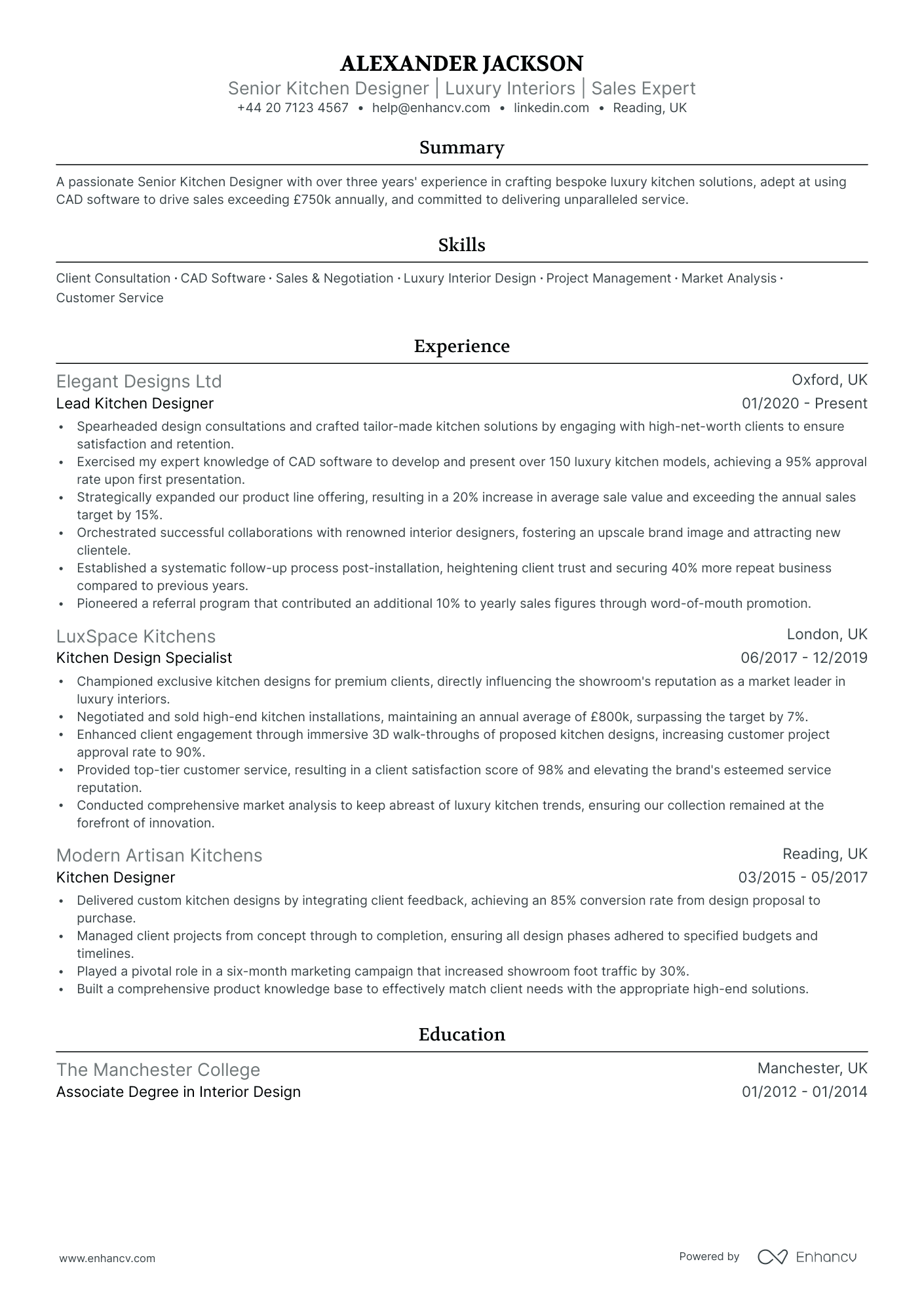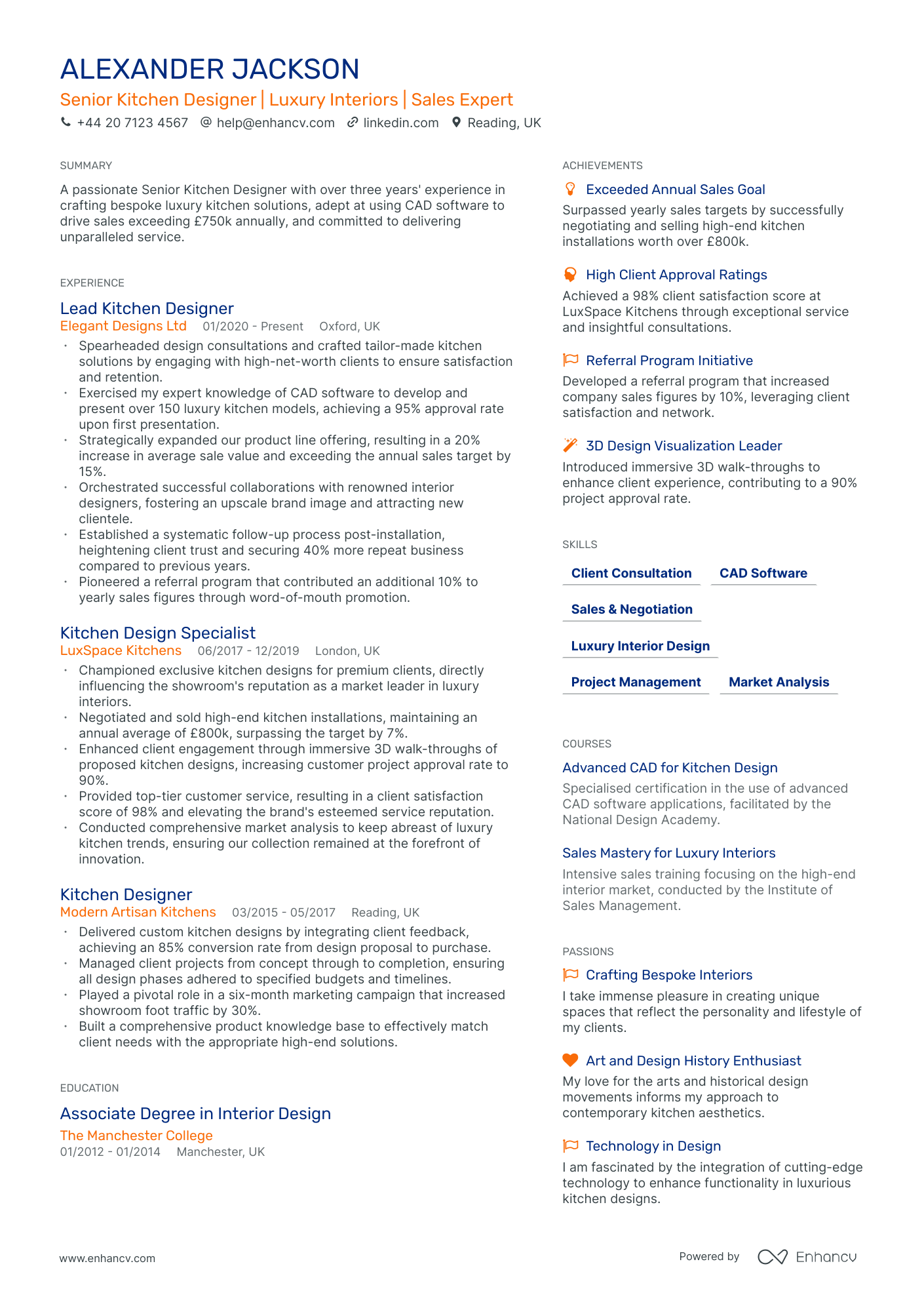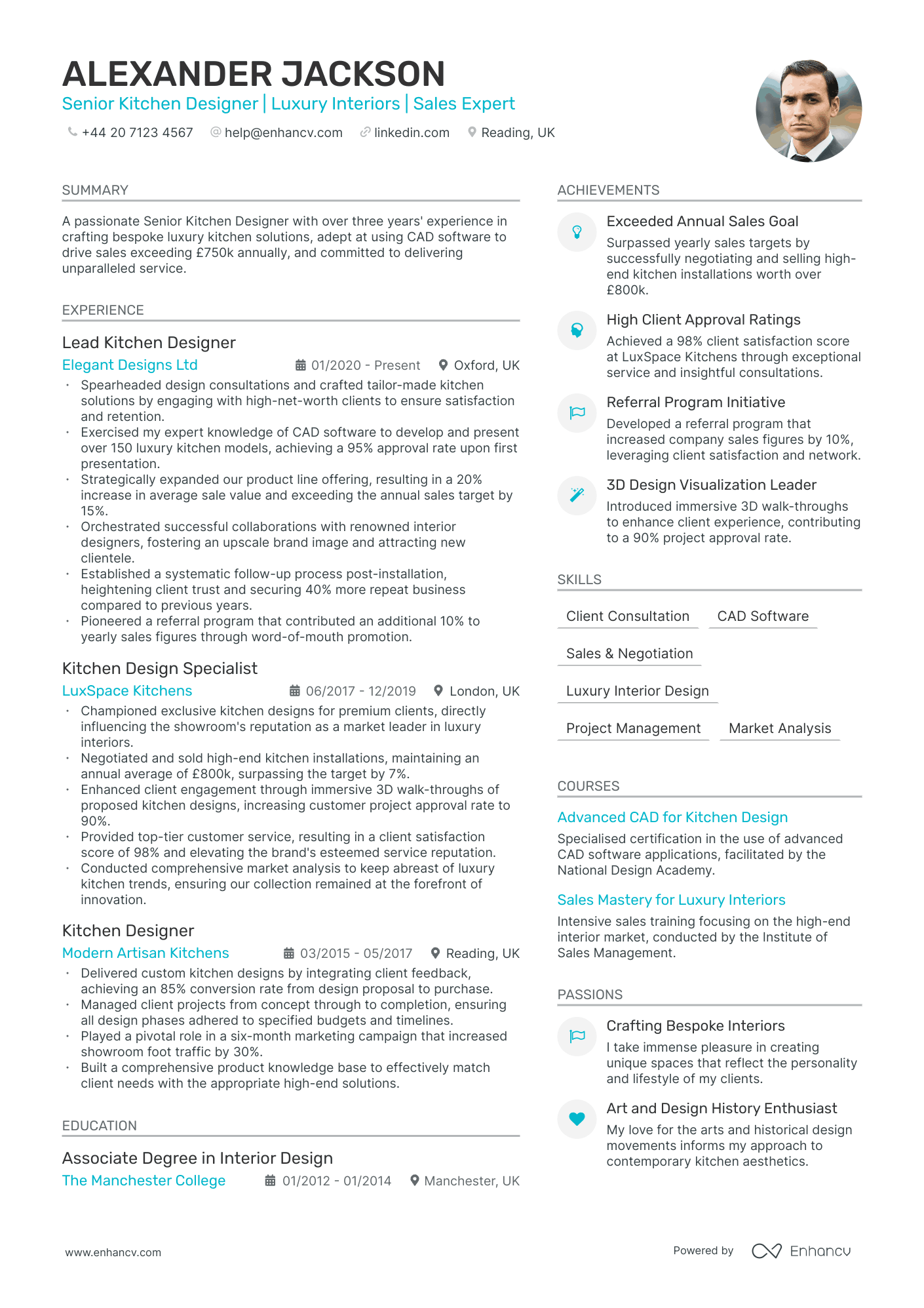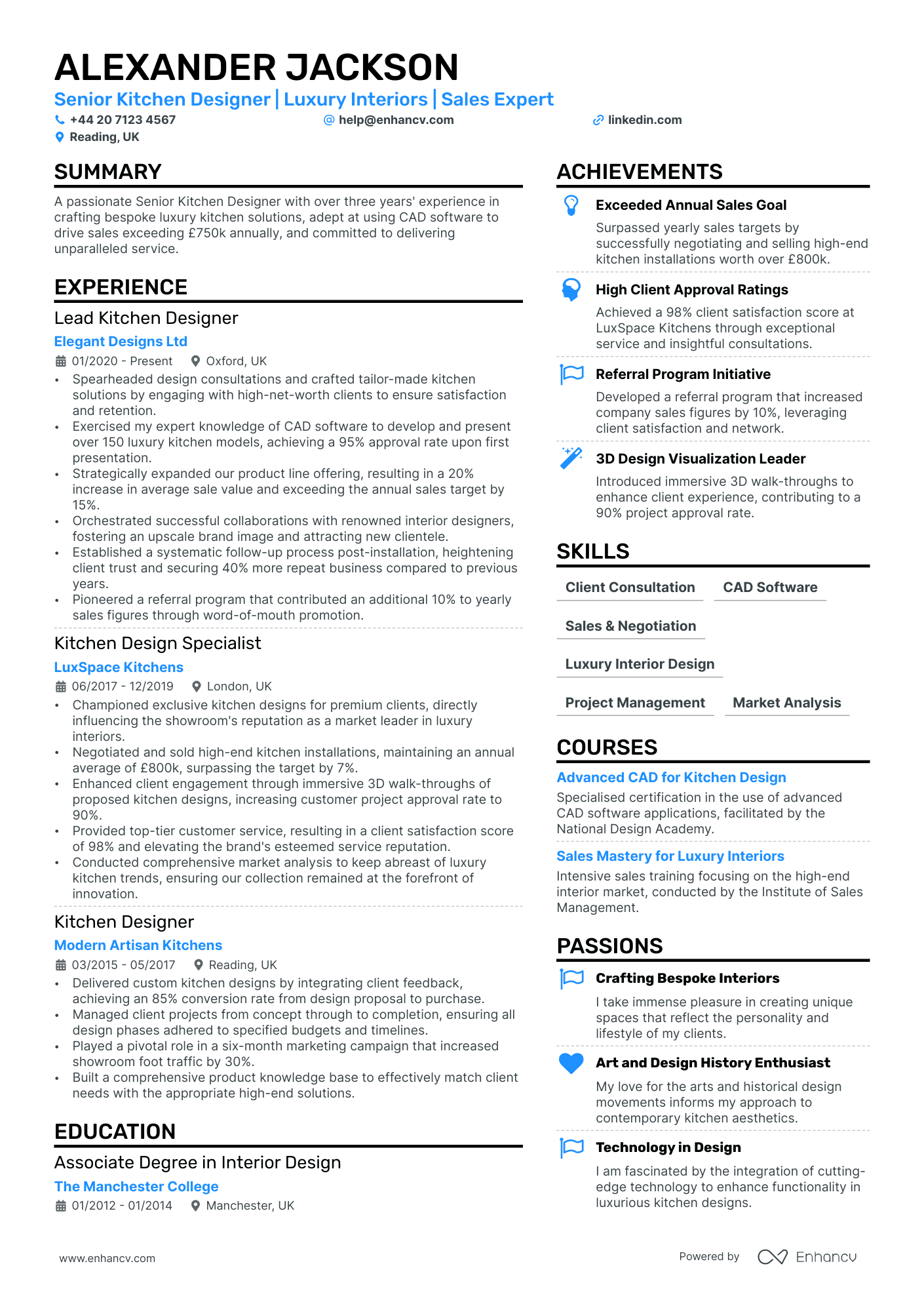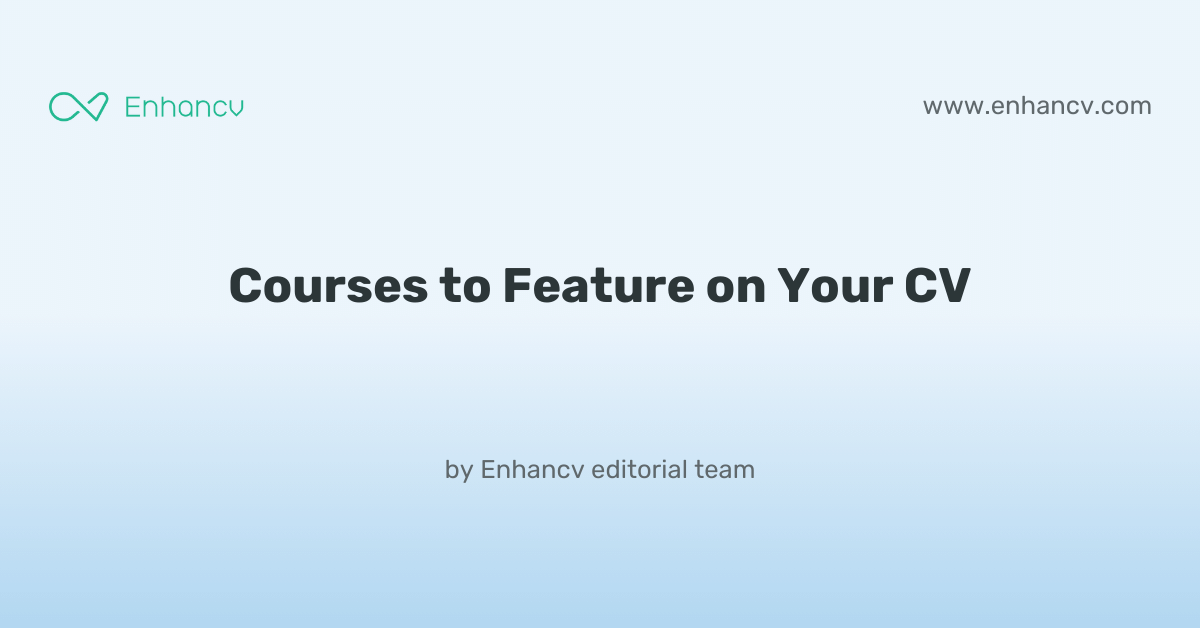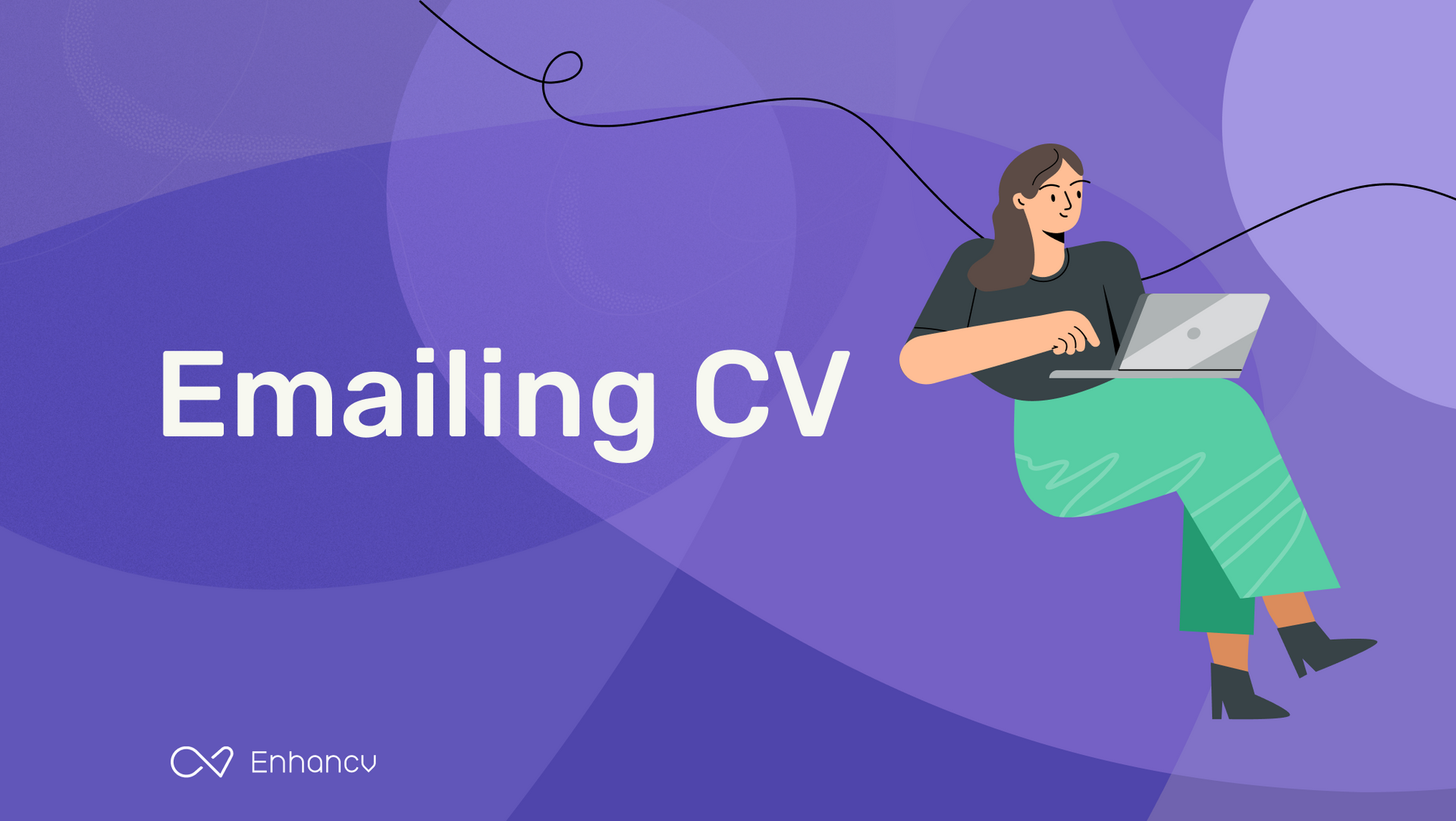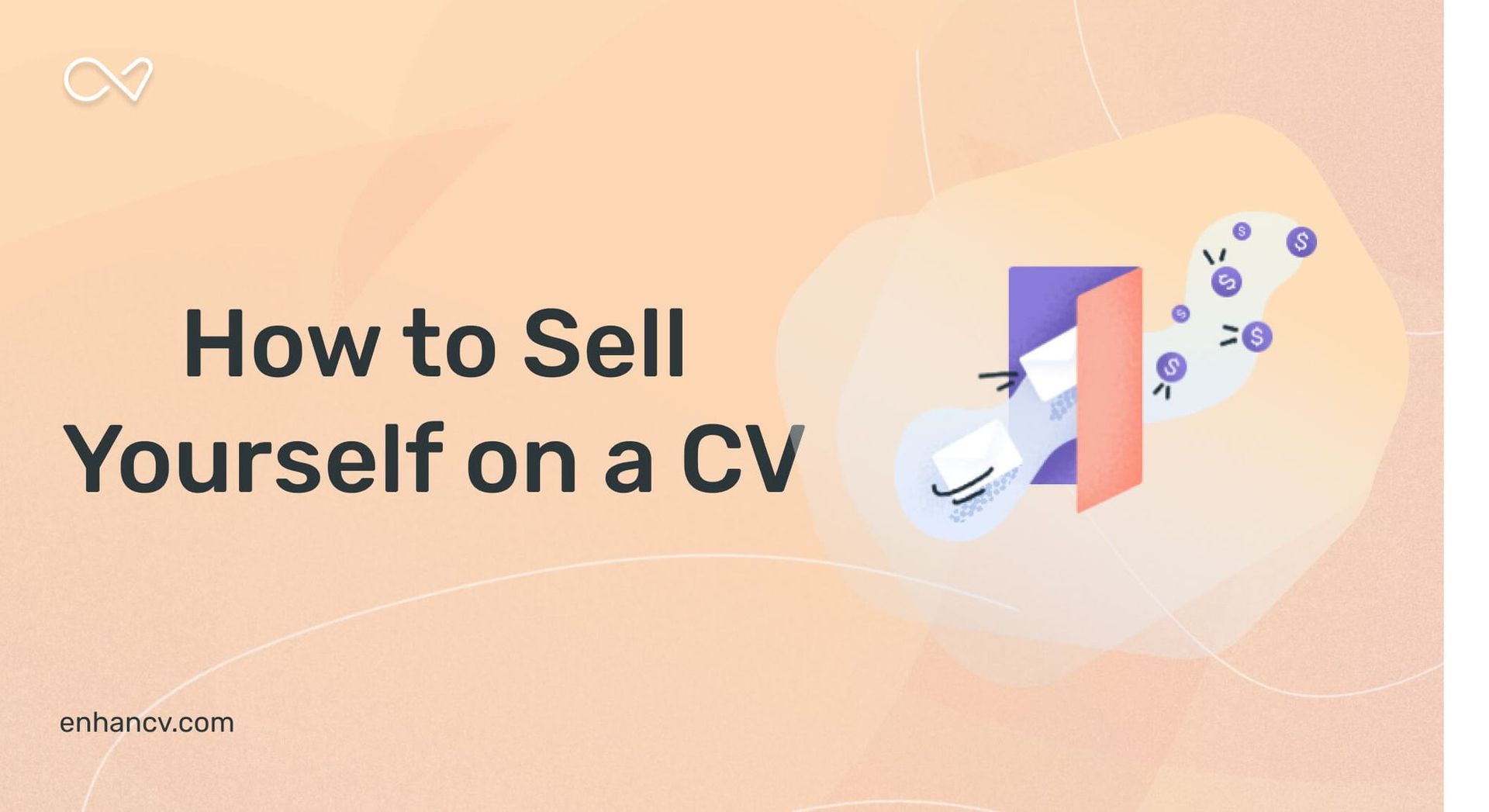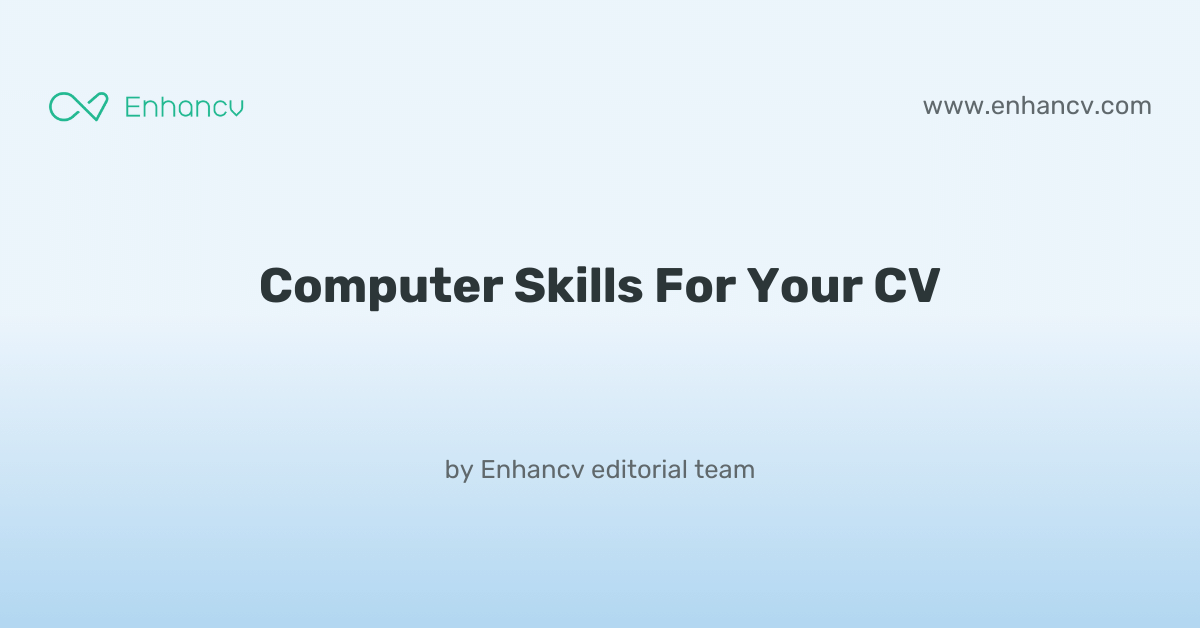One challenge you may face as a kitchen designer is crafting a CV that stands out in a competitive market by showcasing your unique design skills and project management experience. Our guide offers tailored advice on structuring your CV and highlighting your accomplishments, helping you effectively communicate your creative flair and practical expertise to potential employers.
- Design and format your professional kitchen designer CV;
- Curate your key contact information, skills, and achievements throughout your CV sections;
- Ensure your profile stays competitive by studying other industry-leading kitchen designer CVs;
- Create a great CV even if you happen to have less professional experience, or switching fields.
When writing your kitchen designer CV, you may need plenty of insights from hiring managers. We have prepared industry-leading advice in the form of our relevant CV guides.
Structuring and formatting your kitchen designer CV for an excellent first impression
The experts' best advice regarding your CV format is to keep it simple and concise. Recruiters assessing your CV are foremost looking out for candidates who match their ideal job profile. Your white space, borders, and margins. You may still be wondering which format you need to export your CV in. We recommend using the PDF one, as, upon being uploaded, it never alters your information or CV design. Before we move on to the actual content of your kitchen designer CV, we'd like to remind you about the Applicant Tracker System (or the ATS). The ATS is a software that is sometimes used to initially assess your profile. Here's what you need to keep in mind about the ATS:- All serif and sans-serif fonts (e.g. Rubik, Volkhov, Exo 2 etc.) are ATS-friendly;
- Many candidates invest in Arial and Times New Roman, so avoid these fonts if you want your application to stand out;
- Both single and double column CVs can be read by the ATS, so it's entirely up to you to select your CV design.
PRO TIP
Incorporate a touch of colour in headers or section breaks, but keep it professional and ensure it doesn’t detract from readability, especially in more conservative industries.
The top sections on a kitchen designer CV
- Professional Summary showcases your career highlights and design philosophy.
- Relevant Work Experience displays your practical kitchen design expertise.
- Key Kitchen Design Projects illustrates specific examples of work completed.
- Technical Skills and Software proficiency in kitchen design tools and technology.
- Education and Certifications confirm formal qualifications and specialisations.
What recruiters value on your CV:
- Highlight your understanding of different kitchen layouts and your ability to design for both functionality and aesthetics, demonstrating awareness of spatial dynamics and user flow within kitchen spaces.
- Include specific software skills that are pertinent to kitchen design, such as proficiency in CAD programs, 3D rendering tools, or other design platforms commonly used in the industry.
- Showcase your knowledge of materials, finishes, and appliances, and mention any partnerships with reputable suppliers or brands that could benefit prospective clients or employers.
- Detail any experience you have in collaborating with contractors, architects, and clients, emphasising your communication skills and the ability to manage projects from concept to completion.
- Provide evidence of up-to-date understanding of industry trends, health and safety regulations, and environmental considerations in kitchen design by mentioning any relevant courses, certifications, or membership in professional associations.
Recommended reads:
Our checklist for the must-have information in your kitchen designer CV header
Right at the very top of your kitchen designer CV is where you'd find the header section or the space for your contact details, headline, and professional photo. Wondering how to present your the name of the city you live in and the country abbreviation as your address;
- are tailored to the role you're applying for by integrating key job skills and requirements;
- showcase what your unique value is, most often in the form of your most noteworthy accomplishment;
- select your relevant qualifications, skills, or current role to pass the Applicant Tracker System (ATS) assessment. Still not sure how to write your CV headline? Our examples below showcase best practices on creating effective headlines:
Examples of good CV headlines for kitchen designer:
- Lead Kitchen Designer | Bespoke Residential Projects | AutoCAD Expert | 10+ Years Experience
- Senior Kitchen Planner | Functional Space Specialist | Degree in Interior Design | 15 Years in Industry
- Kitchen Design Consultant | Luxury Commercial Spaces | Certified Kitchen Educator | 8 Years' Experience
- Junior Kitchen Designer | Modern Eclectic Styles | Recent Grad with Honours | Passion for Sustainability
- Creative Kitchen Architect | High-End Custom Designs | Member of BIID | 12 Years Crafting Kitchens
- Kitchen Space Innovator | Cutting-Edge Smart Kitchens | Advanced 3D Visualisation Skills | 5 Years Professional Practice
Catching recruiters' attention with your kitchen designer CV summary or objective
Located closer to the top of your CV, both the summary and objective are no more than five sentences long and serve as an introduction to your experience. What is more, you could use either to entice recruiters to read on. Select the:
- Summary, if you happen to have plenty of relevant experience. Feature your most impressive accomplishments and up to three skills that are relevant to the job you're applying for;
- Objective, if you're just starting your career off. Provide your career goals and answer how you see the role you are applying for will match your professional growth.
Judging which one you need to add to your kitchen designer CV may at times seem difficult. That’s why you need to check out how professionals, with similar to your experience, have written their summary or objective, in the examples below:
CV summaries for a kitchen designer job:
- Highly creative and detail-oriented kitchen designer with over 10 years of experience, specialising in luxury residential projects. Skilled in the use of cutting-edge design software such as AutoCAD and SketchUp, and boasting a strong portfolio that highlights a history of exceeding client expectations with bespoke designs.
- Award-winning kitchen designer with a decade of thriving in high-pressure environments. Possesses expert knowledge of sustainable materials and energy-efficient design trends. Record of designing over 50 custom kitchens that have significantly enhanced property values and client satisfaction.
- Seasoned marketing professional now pursuing a passionate career shift into kitchen design, drawing upon 8 years of project management, client relations, and creative problem-solving skills. Extensive experience in home renovation and decoration complements a newfound dedication to crafting functional, aesthetically pleasing kitchen spaces.
- With a background in fine arts and interior styling, bringing 5 years' experience, I am now transitioning into kitchen design. Demonstrated success in visual composition, space planning, and colour theory, laying a robust foundation for creating innovative and personalised kitchen environments that resonate with individual client tastes.
- Eager to embark on a career in kitchen design, where I can leverage my deep enthusiasm for functional art and my degree in interior architecture. Keen to develop hands-on experience, broaden my understanding of space management, and contribute to creating inspiring, user-centred kitchen layouts.
- Aspiring kitchen designer freshly graduated from the London School of Design, aiming to utilise my academic knowledge of design principles and my volunteer experience in home renovations to foster a career that transforms everyday spaces into unique, practical, and stylish kitchens.
How to meet job requirements with your kitchen designer CV experience
We've now reached the essence of your actual CV - your experience section. This is the space where you can list your career roles and on-the-job successes. Many candidates tend to underestimate just how much time and effort they should put into writing this CV section. Your experience shouldn't be a random list of your responsibilities, but instead:
- Match the job description with your skills, values, and accomplishments;
- Start each bullet with a strong action verb, followed up with one key skill and your outcome of applying this skill;
- Spotlight parts of your career history that are relevant to the job you're applying for.
Before we move on, make sure to check out some professional CV experience sections.
Best practices for your CV's work experience section
- Expertly conducted client consultations to understand their needs, preferences, and budget, resulting in customised kitchen designs that blend functionality with aesthetics.
- Successfully managed multiple kitchen projects from concept to completion, ensuring client satisfaction, timely delivery, and adherence to budget constraints.
- Demonstrated proficiency in using industry-standard design software, such as AutoCAD and SketchUp, to create detailed 3D models and realistic renderings of kitchen spaces.
- Maintained an up-to-date knowledge of kitchen trends, materials, and appliances, providing clients with innovative and sustainable design solutions.
- Collaborated with contractors, suppliers, and other tradespeople to oversee the execution of designs, while resolving any on-site issues swiftly to minimise project delays.
- Developed and maintained strong relationships with suppliers to negotiate the best pricing for high-quality materials, enhancing profitability and customer satisfaction.
- Provided exceptional after-sales support, ensuring that any client concerns were addressed promptly and effectively, thereby cultivating repeat business and referrals.
- Facilitated design workshops and training sessions for junior designers, enhancing the skill set of the team and improving the overall quality of design work.
- Efficiently utilised space planning and project management skills to optimise kitchen functionality, storage solutions, and workflow within diverse residential settings.
- Led the design of over 50 custom kitchen projects, incorporating innovative storage solutions and modern aesthetics, which boosted customer satisfaction by 30%.
- Implemented 3D rendering techniques that increased design visualization, resulting in a 25% increase in client approval rates for first-round design concepts.
- Collaborated closely with contractors and suppliers to ensure project materials were sustainably sourced, minimizing environmental impact and reducing costs by 15%.
- Customized kitchen designs to meet the specific needs and preferences of over 100 clients, contributing to a 20% growth in repeat business.
- Negotiated with vendors to secure high-quality materials at competitive prices, leading to a 10% reduction in overall project costs passed to clients.
- Provided expert guidance on color schemes, materials, and appliance integration, enhancing overall design cohesion and functionality.
- Efficiently managed a high volume of kitchen layout plans, averaging 200 per year, while maintaining strict attention to detail and client specifications.
- Facilitated educational workshops for clients about kitchen ergonomics and trends, resulting in a significant increase in informed and satisfied customers.
- Conducted on-site measurements and assessments to ensure accurate and functional designs, leading to a 98% satisfaction rate in design accuracy.
- Expertly translated client visions into detailed kitchen designs, orchestrating the use of premium materials and state-of-the-art appliances for 80+ luxury homes.
- Pioneered a collaborative online platform for real-time design modifications, cutting down project turnaround time by 20%.
- Engaged with architects and interior designers to integrate kitchens into broader home design themes, ensuring seamless aesthetic transitions and functional harmony.
- Spearheaded the launch of an innovative Smart Kitchen line, which incorporated IoT connectivity for appliances, capturing a 15% market share in the first year.
- Overhauled the kitchen design process to include virtual reality walk-throughs, increasing client engagement and reducing time to project sign-off by 35%.
- Directed a team of 10 designers, fostering a culture of creativity and continuous learning that increased team productivity by 40%.
- Successfully completed over 200 individual kitchen designs, catering to a diverse clientele and consistently meeting tight deadlines without compromising on quality.
- Pioneered the application of ergonomic design principles in kitchen layouts, elevating user comfort and efficiency.
- Managed supplier relations and material procurement, ensuring all kitchen projects were completed within budget and to client specifications.
- Executed customized kitchen designs for over 150 residential properties, tailoring each project to optimize space utilization and reflect homeowner personalities.
- Negotiated with manufacturers to integrate cutting-edge kitchen technology into designs, which received high acclaim in local home shows and expos.
- Oversaw the entire design lifecycle, from initial client consultation to final walkthrough, ensuring a cohesive vision and exceeding client expectations.
- Coordinated with a team of designers and installers to oversee the completion of 70+ mid to high-end kitchen remodels annually, resulting in a 35% increase in department revenue.
- Developed and conducted training programs for new design software, enhancing team efficiency and accuracy in kitchen planning.
- Streamlined the design-to-installation process, reducing average project completion time by 15%, thereby improving customer satisfaction and referral rates.
- Designed custom cabinetry solutions for over 120 kitchen spaces, blending functionality with aesthetic appeal, and contributing to a yearly sales increase of 25%.
- Leveraged expertise in sustainable materials to create eco-friendly kitchen designs, which resulted in the company being recognized with a Green Design Award.
- Cooperated with cross-functional teams to integrate client feedback into design enhancements, fostering an iterative design approach that improved final product satisfaction.
- Established a successful freelance kitchen design business, serving both individual homeowners and small developers with tailored design solutions that often surpassed industry standards.
- Integrated advanced technology, including AI-driven design tools, to provide innovative layouts and features, setting a new bar for smart kitchen efficiencies.
- Built and maintained strong client relationships through impeccable customer service and consistent delivery of high-quality designs, leading to a 50% client retention rate.
Lacking professional expertise: how to write your CV to highlight your best talents
Don't count on your lucky stars when you're applying for a role, where you happen to have less (or almost none) professional experience. Recruiters sometimes do hire inexperienced candidates if they're able to present their unique value from the get-go. So, instead of opting for the traditional, CV experience section:
- List any applicable expertise you happen to have - no matter if it's a part-time job, internship, or volunteer work. This would hint to recruiters that your profile is relevant;
- Focus your CV on your transferrable skills or talents you've obtained thanks to your whole life and work experience. In effect, you'll be spotlighting your value as a candidate;
- Separate more space for your applicable academic background and certificates to show you have the technical know-how;
- Ensure that within your objective, you've defined why you'll like the job and how you'll be the perfect match for it. Always ensure you've tailored your CV to individual applications.
Looking for more good examples for your first job? We'll show you how other candidates, with less professional experience, have created their job-winning CVs.
Recommended reads:
PRO TIP
Talk about any positive changes you helped bring about in your previous jobs, like improving a process or helping increase efficiency.
Key kitchen designer CV skills: what are hard skills and soft skills
Let's kick off with the basics. You know that you have to include key job requirements or skills across your CV. For starters, take individual skills from the job description and copy-paste them into your CV, when relevant. Doing so, you'll ensure you have the correct skill spelling and also pass the Applicant Tracker System (ATS) assessment. There are two types of skills you'll need to include on your CV:
- Hard skills - technical abilities that are best defined by your certificates, education, and experience. You could also use the dedicated skills section to list between ten and twelve technologies you're apt at using that match the job requirements.
- Soft skills - your personal traits and interpersonal communication skills that are a bit harder to quantify. Use various CV sections, e.g. summary, strengths, experience, to shine a spotlight on your workspace achievements, thanks to using particular soft skills.
Remember that your job-winning CV should balance both your hard and soft skills to prove your technical background, while spotlighting your personality.
Top skills for your kitchen designer CV:
Computer-Aided Design (CAD)
Technical Drawing
Spatial Planning
Material Knowledge
3D Rendering
Budget Management
Building Codes Familiarity
Project Management
Customer Service
Kitchen Appliances Expertise
Creativity
Communication
Problem Solving
Attention to Detail
Adaptability
Client Focus
Time Management
Teamwork
Sales Ability
Visualisation
PRO TIP
Focus on describing skills in the context of the outcomes they’ve helped you achieve, linking them directly to tangible results or successes in your career.
Further professional qualifications for your kitchen designer CV: education and certificates
As you're nearing the end of your kitchen designer CV, you may wonder what else will be relevant to the role. Recruiters are keen on understanding your academic background, as it teaches you an array of hard and soft skills. Create a dedicated education section that lists your:
- applicable higher education diplomas or ones that are at a postgraduate level;
- diploma, followed up with your higher education institution and start-graduation dates;
- extracurricular activities and honours, only if you deem that recruiters will find them impressive.
Follow a similar logic when presenting your certificates. Always select ones that will support your niche expertise and hint at what it's like to work with you. Balance both technical certification with soft skills courses to answer job requirements and company values. Wondering what the most sought out certificates are for the industry? Look no further:
PRO TIP
Use mini case studies or success stories in your CV to demonstrate how your skills have positively impacted previous roles or projects.
Recommended reads:
Key takeaways
Here are five things you need to remember about writing your kitchen designer CV for success:
- Sort your experience based on the reverse chronological order, starting with your most recent career items, to showcase how you've grown your career;
- Include within your CV header your relevant contact details, a headline that could spotlight your unique value, and a photo - if you're applying for roles outside the UK or US;
- Decide to use the CV summary, if you happen to have more professional experience, and an objective, if you want to showcase your career goals;
- Within the experience section, write your bullets using action verbs, skills, and success, instead of just merely listing your on-the-job responsibilities;
- Prove your technical skills, using your education and certificates, and your soft skills, with your achievements and strengths sections.
